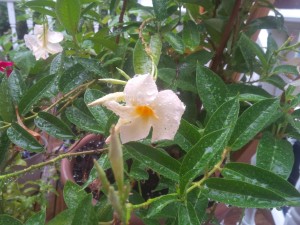 It is hot and sticky and many of my plants, in-ground and in containers, are sulking. They sulk even though I water them and feed them. It is like having teenagers with foliage. As with teenagers, there is really nothing to be done except to continue the good work, and hope that all that loving care will pay off eventually.
It is hot and sticky and many of my plants, in-ground and in containers, are sulking. They sulk even though I water them and feed them. It is like having teenagers with foliage. As with teenagers, there is really nothing to be done except to continue the good work, and hope that all that loving care will pay off eventually.
There is one plant, however, that refuses to sulk, maintains its good looks and brings me joy every day as I ply the watering can. It is a yellow-flowered mandevilla or Mandevilla x amabilis. Its ancestors lived in the tropics, and though it is a hybrid, its genes have given it a high tolerance for hot, humid conditions.
The species mandevillas that gave rise to modern specimens grew happily for centuries in Argentina and Chile. Back in 1837, when England’s Queen Victoria was a sweet young thing, new to the throne, and not even officially crowned, one of her diplomats sent a new plant back to England. The diplomat was Henry Mandeville, who was serving Her Majesty as Minister in Buenos Aires, Argentina. Mandeville, like so many of his globe-trotting contemporaries, was also an avid amateur botanist. When not conducting diplomacy, he conducted plant hunting forays. One of those resulted in the discovery of a vining plant with white, trumpet-shaped flowers. Originally given the rather non-harmonious genus name “Dipladenia”, the vine eventually acquired a name that honored its discoverer–Mandevilla laxa. Admirers, who were more concerned with romantic associations than geographic origins, christened it “Chilean jasmine.”
Mandevilla laxa eventually found its way into the hands of plant breeders, and became one of the parents of Mandevilla x amabilis, which is enjoying intense popularity right now.
“Amabilis” means “lovely”, which is a perfect description of my hybrid mandevilla and its relatives. A healthy, mandevilla, with its flexible stems trained on a trellis, tuteur or other sturdy support, can grow to ten feet tall and four feet wide. Those who are fearful of such rampant growth can take comfort in the fact that some modern hybrids top out at 5 feet and can be kept shorter with a bit of pruning. Other varieties have been bred for a mounding, bushy habit, rather than a climbing or trailing one.
If you look at mandevilla flowers closely, they are fascinating. The long, slender buds are furled, much like tightly rolled umbrellas. They open into deep-throated flowers, each of which lasts a few days before making a clean drop from the plant. The flower form is characteristic of the Apocynaceae or dogbane family. If you have Vinca minor, sometimes known as myrtle or periwinkle, growing in your garden, you will see the resemblance between mandevilla and vinca flowers. As is characteristic of dogbanes, mandevilla stems exude a milky sap, which can be irritating to the skin of some individuals.
As with many tropicals, the foliage is attractive even when the plant is not blooming. The abundant crinkled leaves are oblong and grow anywhere from three to eight inches long, making for an eye-catching display.
The first popular hybrid mandevilla was the lovely ‘Alice Dupont’, a pink-flowered variety bred at Pennsylvania’s Longwood Gardens and named after the wife of its founder. But plant breeders never rest in their pursuit of new varieties, and over the course of the last couple of decades we have seen the introduction of vivid red mandevillas, not to mention plants with white, salmon, apricot and sunny yellow blooms. My yellow-flowered specimen gets along well with flashy summer stalwarts like hibiscus and canna, but will also make lovely music with the less flamboyant asters and mums that will join the floral symphony as fall arrives.
These days, mandevilla is fairly common and relatively inexpensive, so many gardeners treat them as annuals, using them freely in flower borders or container plantings and trundling them to the curb or compost pile at the end of the growing season. With prices of everything going up everywhere, you may want to overwinter your tropical beauties in sunny indoor spaces.
To overwinter a mandevilla, simply take the entire pot indoors when outdoor temperatures drop below 60 degrees Fahrenheit. Place it in a sunny spot and trim back, if necessary. From October through March, the mandevilla rests up for the next growing season, so water only when the top of the soil feels dry and don’t be offended when you see leaf drop and few signs of growth. At the end of March, begin watering more regularly and feed the plant with commercial plant food diluted according to package directions. When you and the mandevilla can be comfortable outside—as temperatures exceed 60 degrees–take the plant back to your porch, terrace or garden. The growth and bloom cycle will start all over again.
Sun-loving mandevillas are comfortable as single, specimen plants, but can also share space companionably in mixed borders. I have seen an array of eight or ten red-flowered plants trained along a black, wrought iron fence and the effect was glorious. For something a little different, try growing one in a large hanging basket with those long flower-laden stems trailing over the sides.
If you haven’t invested in a mandevilla yet, now is a great time to pick one up on sale. Check out the sale areas of local nurseries and garden centers for end-of-season bargains. The growing season still has a long way to go. Mandevilla may not be able to cure all the world’s ills, but it will make you feel better about your personal space.
